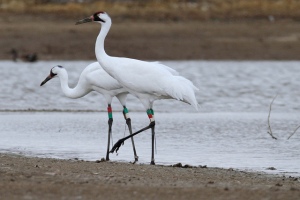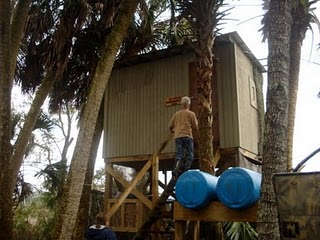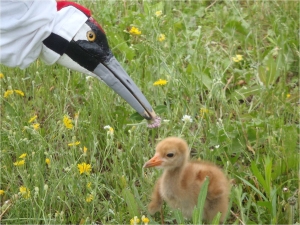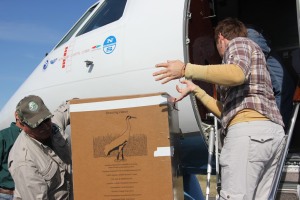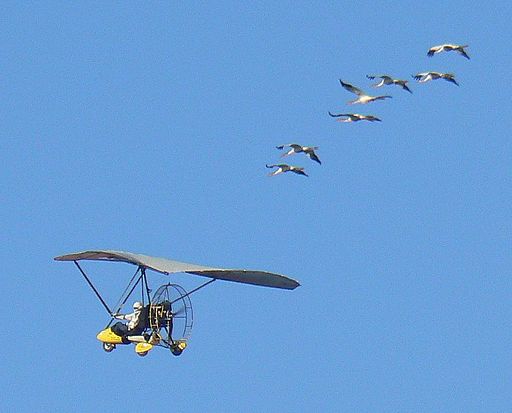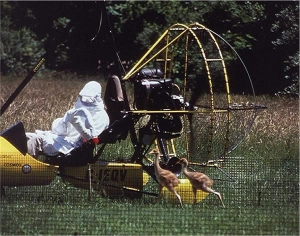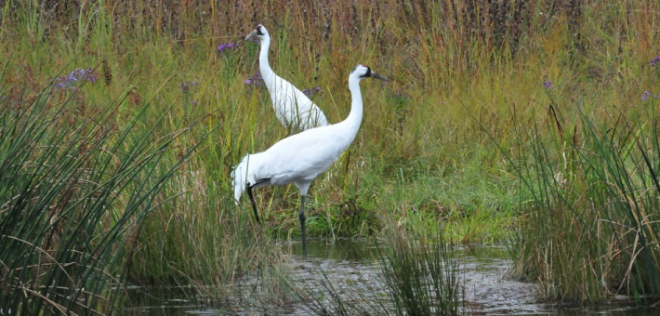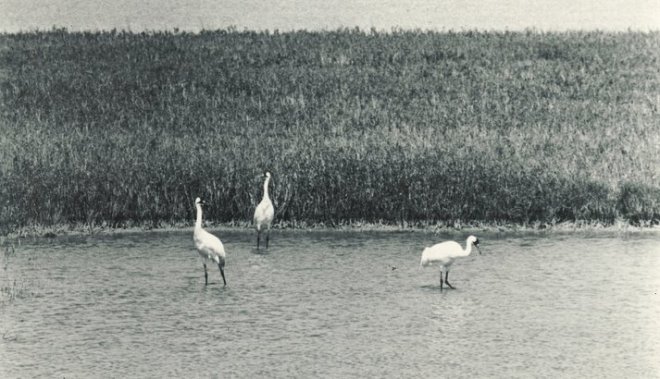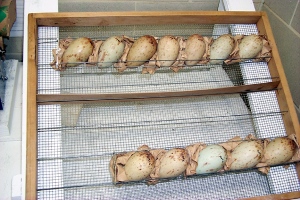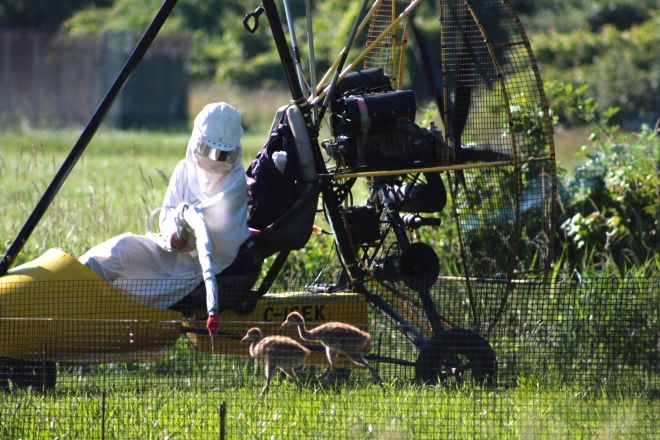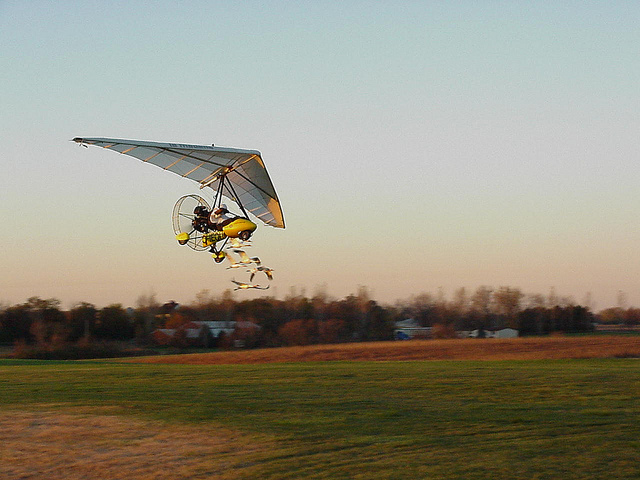This is Part 2 of the Winter 2016 news to report about the whooping cranes of the Eastern Migratory Population.
Below, you will find reports on:
– The Last Flight of Operation Migration
– The Release of the Class of 2015
– News of the two surviving wild chicks of 2015, and their families
– An update on the 8 Direct Autumn Release chicks of 2015, and the two surviving Parent-Reared chicks.
The Last flight of Operation Migration
It was a long slow final migration for Operation Migration and its six Class of 2015 ultralight-led whooping cranes. It was made so mostly by weather conditions that kept the project grounded for long stretches waiting for the perfect conditions necessary for the cranes and ultralights to fly together.
Time finally ran out while waiting for those conditions for the final brief 23 mile flight and the cranes were crated and driven to the winter pensite at St. Mark’s National Wildlife Refuge so they could be released and eased into their real lives in the wilderness. They could be off on their first, unaided migration north to WI in as little as six weeks, and they need time in Florida to learn how to be on their own.
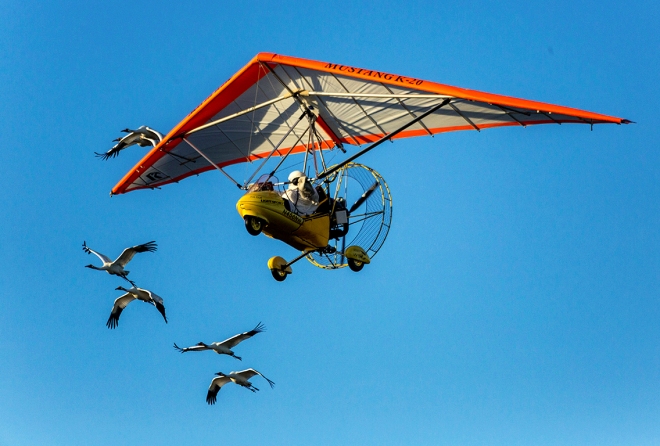
Operation Migration in the air for the last time with ultralight-led whooping cranes; the final flight together with the Class of 2015. This photo is by Karen Willes, who has photographed the ultralight-led cranes’ arrivals at St. Marks National Wildlife Refuge every year since 2009. She was in Georgia, January 30th, to capture this dramatic shot of pilot Richard van Heuvelen and the six Class of 2015 cranes. Photo used with permission. (Can you see two birds, flying just off the right wingtip?)
By some good fortune, there were veteran whooper watchers and photographers from Tallahassee, who traveled to southwestern Georgia when OM and the cranes made their second last flight. And that’s the one that, as it turns out, is the true final flight of Operation Migration and its ultralight-led whooping crane program. See the photo above, captured by Karen Willes, of this historic moment in the long campaign to reintroduce a second flock of migrating whooping cranes.
The Release of the Class of 2015
The last six ultralight-led cranes are now in the fourth and final phase of their training for real life – the “release phase.” Think of the phases this way: from hatching at Patuxent National Wildlife Research Center until their transfer to Wisconsin in early summer they were in the pre-flight training phase. In Wisconsin throughout the summer, they were in full flight training phase, and in the fall they left on migration to Florida, following the ultralights – the learning migration phase.
This fourth phase involves their release into an enclosed 4-acre marshy area of St. Mark’s NWR. They have their freedom to fly in and out of it, but their comings and goings continue to be monitored by a small staff of silent, costumed crane handlers. There are several fine posts at OM’s Field Journal right now that describe in great detail what is happening in the fourth phase.
The Stressful Process of Banding Whoopers:
The 2015 chicks were released at St. Marks Saturday, Feb. 6, and the first really important thing to happen to them after that, was the process of banding – during which identification bands and tiny tracking transmitters are attached to the legs of each bird. The cranes were kept in a small holding pen until the banding on Tuesday, Feb. 9th, and returned there for a few days following so they could acclimate, and be closely observed.
“Banding is always a stressful time for birds and crew,” OM’s Brooke Pennypacker writes. “The stress can cause injury and even death, and unfortunately, has.” But not this year! In the post, “With This Ring . . .“ Brooke describes banding step-by-step, and introduces the banding crew of nine, which included Dr. Richard Urbanek, retired USFWS biologist, and Scott Tidmus, a manager of Disney’s Animal Kingdom, and “long time friend and volunteer on the project.”
In addition to Brooke’s helpful explanations, the post (check it out) includes gorgeous portraits of the individual birds, each with their new color-coded bands and transmitters.
Take a Virtual Tour:
Other posts to see include Brooke’s “They’re Here! Whooping Crane Socialization,” in which he describes the interactions between the six chicks and four older adult birds that are happily hanging out at the pen this year. And Heather Ray’s word & picture tour of St. Mark’s NWR Release Pen. It is a virtual visit to an area the public can never see.
Where the Wild-hatched Chicks Are: W10-15 and W18-15
Last year’s bumper crop of chicks that were hatched in the wild was unlike anything ever seen before in this reintroduction project – 24 chicks were hatched in and around Necedah National Wildlife Refuge during the spring of 2015. It was phenomenal! But the bad news that followed that best-ever nesting season is that only three of those chicks survived to fledge and one of those fledglings died on the refuge, of a respiratory infection, before migration.
So where are the two that did survive and migrate with their families?
Crane tracker Hillary Thompson recently encountered both families. In late January she blogged about finding the family group, female 9-03 and male 3-04, with their chick, w18-15, at Wheeler National Wildlife Refuge in Alabama. On February 3rd, she recorded the thrill of finding w10-15 alive and well with its family group (female 25-09 and male 2-04) in Kentucky.
Hillary was on the staff of the International Crane Foundation, from 2012 through 2014, “. . . and still haven’t quite left,” she writes on her blog’s “about” page. She is also currently working on a master’s degree from Clemson University”s Department of Forestry and Environmental Conservation.
Here is a bit more about the crane parents raising the wild chicks:
Detailed biographical records for each crane, which are kept by Journey North, make this report possible.
The female, 9-03, and her mate, 3-04, are one of the most successful parenting partnerships among the Wisconsin cranes, having now raised 3 chicks to fledge. In addition to w18-15, they were the parents of w1-10, who died in November 2013 after 3 and a half years of life, and w3-13 who died in December 2013 while on her first migration with the parents.
The pair raising w10-15 are a 2004 male (#2-04) and 2009 female (#25-09). The male of this pair has achieved his new status as whooping crane father after 3 mates and many almost-a-dad experiences. He and his first mate, 46-07 successfully hatched a chick in both 2011 and 2012, though neither survived to fledge and his mate died in August, 2012.
With a new mate, female 8-09, he successfully fostered the parent-reared 24-13, during fall 2013 and into the next spring. He and mate 8-09 had a successful nest in 2014, but their nesting ended sadly with the discovery of her death in mid-April. Male 2-04 mated again before the end of summer, and with his current partner, 25-09, successfully fostered another parent-reared chick, 27-14.
The pair and their fostered chick were back at Necedah NWR by March 31st last spring, and the successful foster parents soon had their very own newly hatched wild chick. Hopes are high for both surviving wild chicks, #10-15 and #18-15, that both will live long, and each will become a source for future Wisconsin whooping cranes.
And Here Are the Rest of the Chicks of 2015
Eight chicks that hatched in captivity in 2015, and designated for the Eastern Migratory Population of whooping cranes, were raised at the International Crane Foundation for the Direct Autumn Release program. This year they are designated #61 through #68-15. (I’ve written before about this release method; this post describes its mission and methods.)
Locating the DAR birds:
The eight have all been reported on migration and the whereabouts is known for all but one of them. That one, #64-15, was recorded having left on migration with a large group of sandhill cranes “a few days before November 24. Her signal was last heard as she traveled over Madison, WI . . .” (from the biographical notes kept by The Journey North).
A group of five of these 2015 DARs left Horicon NWR completely on their own, December 19th – not with sandhill or whooping cranes. They are #s 61, 62, 63, 65, and 67, and they were reported in an update from the Whooping Crane Eastern Partnership (WCEP) as located for a while in McHenry County, IL; #65-15 soon split from the group and followed a group of sandhills to the Goose Pond area of southern Indiana. The other four continued southwest, and are located on the border of Randolph County, IL and Sainte Genevieve County, MO.
Here is the location of the other two 2015 DAR birds: #68 went with sandhills to the Jasper-Pulaski Wildlife Area in southern Indiana, and #66 followed Sandhills there, and then on to Lake County, in Florida.
The Parent-Reared birds go it alone this year:
The two Parent-Reared birds of 2015 – neither of them in a foster family of whooping crane parents – have been tracked to Wheeler NWR in AL (#14-15) and St. Martin County, LA ( #20-15). (See Can Captive Whooping Cranes Raise a Chick for the Wild? for more information about the Parent-Reared release method.)

